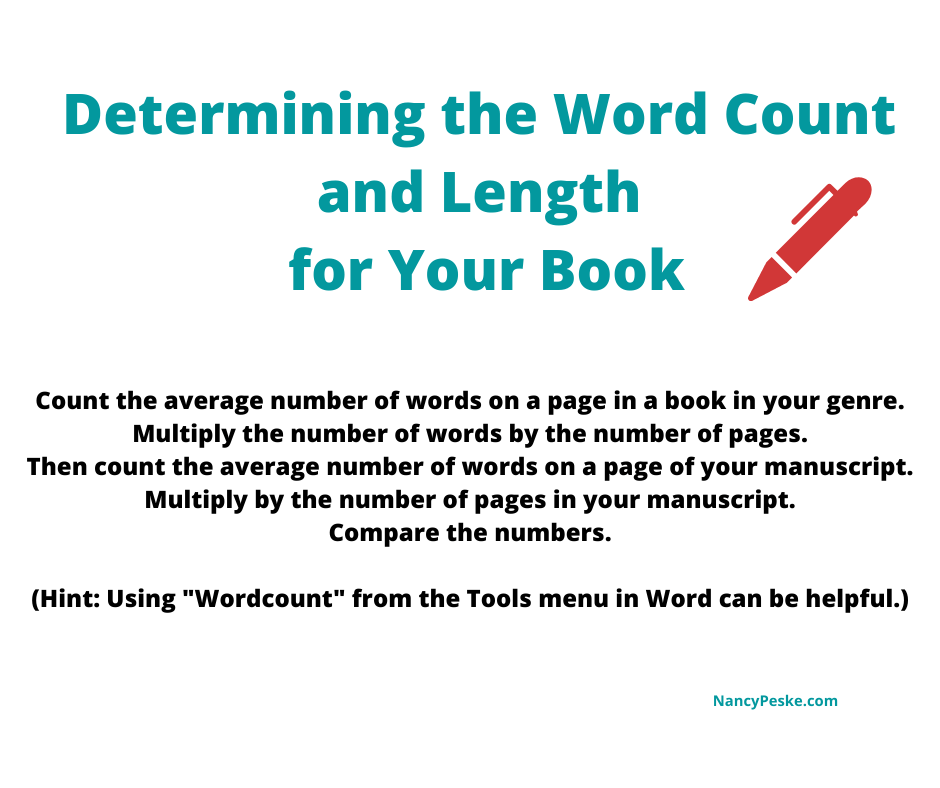THE WORD ON WORD COUNT AND LENGTH
How do you determine word count and length for a book and its chapters?
First, study other successful (key word: successful!) books in your genre to discover their length. For example, a typical self-help book is between 60,000 and 80,000 words in length. Don’t worry about pages for now. Editors, publishers, and agents usually think in terms of words, not pages. That’s because a page of a book or manuscript could have anywhere from 200 to 500 words on it. It’s more precise to think in terms of word count. In fact, if I’m asked to work on a book “of about 200 pages,” I will ALWAYS ask about the actual word count.
To determine the word count of a book, count up the words on a typical page. Then multiply by the number of actual pages (don’t count the copyright page, title page, index pages, etc.). I use the Chisanbop method of counting on my hands to 100 to quickly calculate page numbers, shouting aloud “one hundred!” or “two hundred!” to ensure that I don’t forget what hundred I’m on. (Note that most pages will hold 200 to 400 words).
To determine the word count of your Microsoft Word document (or a highlighted section), go to the Toolbar and from the TOOLS pull-down menu choose WORD COUNT.
Once you’ve determined what your book’s chapters will be, you will have to figure out how many words you’ll need per chapter to meet those word count parameters.
Let’s say you’re aiming at 70,000 words and you’ve come up with 14 chapter ideas. Assign a few thousands words to the front matter and back matter. (Front matter for a book consists of the title page, copyright page, contents page, acknowledgements, and the like, and perhaps extra sections such as a preface, introduction, and foreword. The back matter will have such elements such as an afterword, a resources section, endnotes, and an index). Subtracting for the front and back matter leaves you with about 67,000 words. Divide that figure by 14 chapters and you end up with 4785 words allotted for each chapter.
Typically, a self-help book will have at least ten chapters but less than twenty. Also, most chapters will be approximately the same length. If you have several 15-page-long chapters and one that’s 36 pages long, consider whether you could split it into two different chapters or whether you’ve simply written too much on that topic and need to save it for another book. I’ve found it’s common for an author to realize this unwieldly chapter can be tamed and serve as the seed for his next book, which will look at that topic in depth.
When looking at successful books to determined their word count and length, pay attention to how many chapters they have and how long the chapters are. How much of the book is devoted to the “action plan” versus background material for understanding the book’s fresh ideas? Novelists and memoirists should be looking at length, too. If you aspire to write the next Eat, Pray, Love or Twilight series, how long should your book be? Remember that while the brilliant Harry Potter series ended with some hefty tomes, the first book was a more standard length publishers and readers are familiar with.
Take a few good books off your shelf and take a look at their word count. Familiarize yourself with your genre’s most typical length. Then, think long and hard about breaking the rules. Writing a book that’s very short or very long compared to its buddies on the bookshelf can make it difficult for you to get a book deal or entice readers to pick up your book.


Nancy Peske is a ghostwriter, developmental editor, and book publishing consultant who has done editorial work on books including bestsellers and award-winners for over 30 years.